Types of Juncos and How to Identify Them
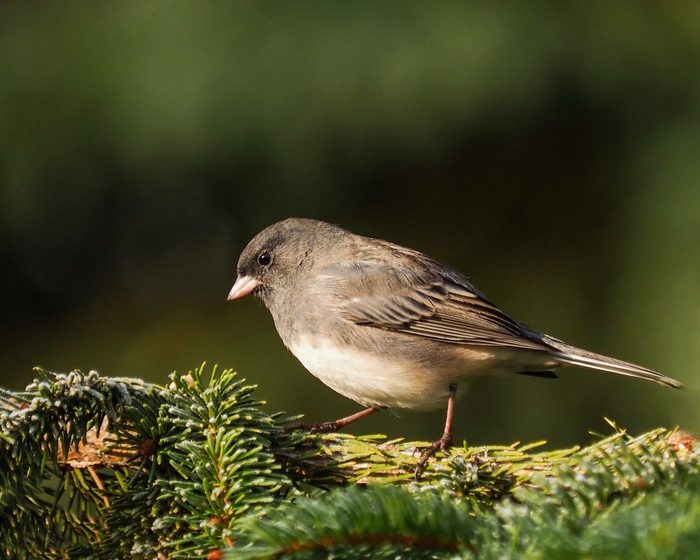
Dark eyed juncos wear subtle hues of gray, brown and white, with round little bodies and sweet expressions. They are often referred to as snowbirds because they appear to carry gray storm clouds on their backs and white snow on their bellies. But they also earn this nickname because of the cadence of their southerly migration—they fly into many areas just in time to usher in winter snows. Juncos show a remarkable amount of variation from place to place. Their regional color forms were previously classified as separate species. Now most have been combined under the name of dark eyed junco, but it’s easy to recognize the differences in plumage. Depending on where you live, you might expect to see multiple types of juncos, including the slate colored junco and Oregon junco.
Eastern vs. Western Junco Species

Depending on where you live, your juncos may look different. Those found in the eastern half of the U.S. are charcoal gray on top with white bellies and known as slate colored juncos. The most common variety in the west is called the Oregon junco. Other types of juncos, like white-winged and gray-headed, are less common with limited ranges. Always look for their signature field mark—a pretty pink bill.
Learn about western birds and their eastern counterparts.
All Types of Juncos Are in the Sparrow Family
Look for these dark-eyed beauties in mixed flocks with other sparrows and bluebirds. They fit in well with these birds because juncos are actually members of the sparrow family, despite their different color pattern. Where junco ranges overlap, you may find several types of juncos in one winter flock.
Slate Colored Junco

Of all the forms of dark eyed juncos, the the slate colored type has the widest range. Find slate colored juncos in summer across most of Alaska and Canada, south into the northeastern states and the Appalachians, and as far south as Georgia. In winter they are common from southern Canada to the Gulf states, mostly east of the Rockies but with a few scattered throughout the West.
Slate colored juncos are the least colorful of the juncos, with their basic gray and white, but they are still beautiful in their simplicity. They share some similarities with other types of juncos, such as their white outer tail feathers that are obvious when they fly. In addition, they almost always build their nests on the ground, usually in a spot well hidden under shrubs or overhanging branches. And, like other juncos, they form small flocks in winter, often joining with other birds, such as white-throated sparrows or American tree sparrows.
For their winter habitat, juncos favor partially open areas, including the edges of woods and suburban backyards. White proso millet, sunflower chips and other types of high-quality seeds lure them to feeders. They are most likely to use open-tray feeders close to the ground and often just forage on the ground underneath the feeders. Find out what foods juncos eat.
Oregon Junco

The Oregon junco is the most widespread type of junco in the West. They have a nesting range that stretches from southeastern Alaska through western Canada, to Idaho and Wyoming, and south throughout the West Coast states. Oregon juncos are found in summer in the high mountains and along the coast in Washington, Oregon and California. They readily adapt to nesting in parks and gardens, so they’re actually year-round backyard birds in many places.
Oregon juncos don’t all look the same. In some areas the males have black heads, while in other areas the heads are dark gray or blue-gray. The colors of the back and sides vary from dark brown to bright cinnamon to pale pinkish brown. All are more colorful than the slate colored juncos of the East.
Junco vs chickadee: Here’s how to tell the difference.
White Winged Junco

The Black Hills area of South Dakota makes up most of the summer range of the white winged junco. Despite its name, the bird has wings that are mostly gray with only two narrow white wing bars. Aside from those marks, it looks like a slightly larger, paler gray version of the slate colored junco.
Discover 12 winter bird myths and facts.
Pink Sided Junco

Just out to the west, in Wyoming and southern Montana, is the summer range of dark eyed juncos that are also large and pale, but with brown backs and pinkish buff sides. The birds are sometimes called pink sided juncos but are occasionally considered a type of Oregon junco. Both white winged and pink sided juncos spread south in winter, mainly along the east side of the Rockies.
Learn how to attract a chipping sparrow.
Gray Headed Junco

The mountains of Colorado, Utah and Nevada are the main summer range of the gray headed junco. This bird is mostly gray, including its head, back and wings, but the center of its back is a bright reddish brown. Like the other dark eyed juncos, its bill is pale pink.
Psst—here’s how to identify a song sparrow.
Red Backed Junco

But just to the south, in the mountains of central Arizona and New Mexico, lives a bird that looks almost the same but with a bill at least half black. Called the red backed junco, it’s less migratory than most of its cousins, generally staying in the same mountain forests during all seasons.
At some places in the West, three or four types of dark eyed juncos may mix together in the same winter flocks. In the East, almost all the juncos are of the slate colored type, but the occasional Oregon junco wanders as far east as the Atlantic Coast. Wherever they go, whether they herald the coming of snow or just a mild change of seasons, these gentle, attractive birds are always welcome visitors.
Next, learn the difference between a western bluebird vs eastern bluebird.
1. Juncos Are Nicknamed Snowbirds

The dark eyed junco has a cute nickname: snowbird! This is because a junco bird seems to bring snowy winter weather on its wings as it migrates. In the colder months they travel in flocks of 15 to 25 from northern evergreen forests to backyards all over the U.S.
Learn what a dark eyed junco looks like and sounds like. Oh, and you can’t miss out on these adorable junco bird pictures.
2. Their Namesake Bird is Endangered
Named for its natural habitat of Guadalupe Island, the Guadalupe junco is now endangered. Unique to Mexico, there may be fewer than 100 left in the world.
Junco vs chickadee: Here’s how to tell the difference.
3. One Junco Bird Species Has Many Variations
The subspecies of dark eyed juncos fall into five major groups: gray-headed, Oregon, pink-sided, slate-colored and white-winged.
Psst—did you know juncos are in the sparrow family?
4. Juncos Have a Long Lifespan
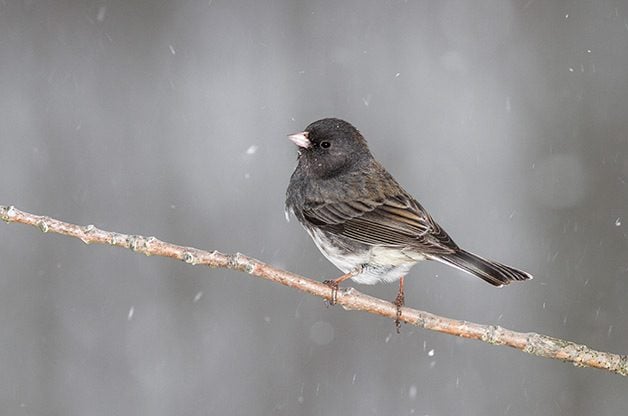
Banding records show that a dark eyed junco bird can live to be 11 years old. Can you guess how long hummingbirds live?
5. Look for Juncos on the Ground
Juncos make their home in woodland areas. Sure, they’ve got wings, but juncos prefer to hop around the forest floor. They spend as much as 65% of their time on the ground. Discover the best way to attract birds that don’t visit bird feeders.
6. Cold Weather Doesn’t Influence Junco Bird Migration
Beginning in 1924, biologist William Rowan’s research on dark eyed juncos revealed that these migratory birds respond more to changes in daylight than temperature. Learn why some birds migrate and others don’t.
7. Juncos Puff Up in Winter

When it’s cold outside, juncos grow down jackets. The coat of feathers on a junco bird is 30% heavier in winter than in summer.
8. Juncos Have a Favorite Birdseed
Attract juncos to your backyard ground feeders with millet. This small seed comes in two types, red and white.
Next, learn how to identify the American tree sparrow and chipping sparrow.
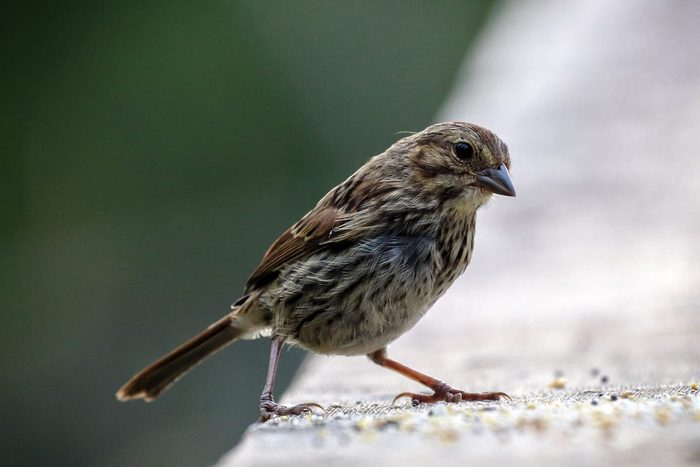
When you see small, sweet creatures hopping along, it seems so harmless to draw them in with whatever snacks you have available. Though the urge is fierce to feed birds bread and other convenience foods, try to resist. Dishes people consume, like bread, are generally bad for birds in the same way that junk food is bad for our systems.
“Malnutrition is certainly a risk if birds aren’t getting the food that they need,” says John Rowden, former senior director for bird-friendly communities at Audubon. “They can be undernourished, which makes them more susceptible to disease, so it could cause health or lethal consequences.” With that knowledge, here’s a list of nine nibbles to avoid feeding your feathered friends.
Check out a list of safe foods birds can eat from the kitchen.
On This Page
Is Bread Bad for Birds?
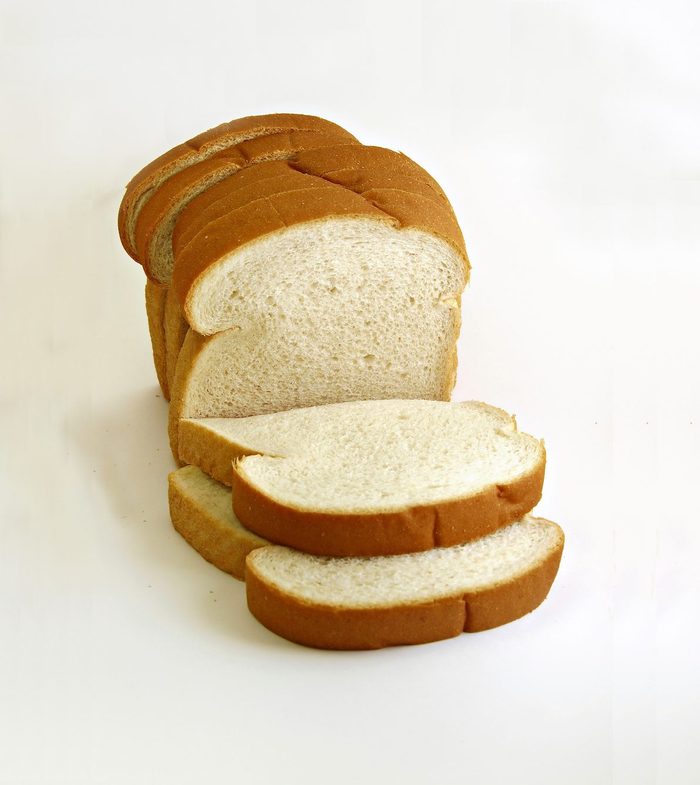
People often ask if birds can eat bread and if bread is bad for birds. Because bread causes birds to become full quickly, fliers may skip foods with actual nutritional value. Birding experts Kenn and Kimberly Kaufman say, “We discourage people from feeding bread to birds, as there are far too many potential risks.
If moldy, bread can be dangerous to birds. Bread gets moldy quickly, and mold can pose a number of health problems for birds. If the chunks of bread are too large, they can actually block the digestive tract. Bread is also more likely to attract raccoons, rats and other unwelcome guests.”
Kenn and Kimberly add, “A regular diet of bread products fed to waterfowl can cause serious harm. So if birds consume bread on a regular basis, the lack of nutrients causes vitamin deficiencies that lead to serious, even fatal health issues.”
Learn what foods you can feed to ducks.
Raw Meat

It might seem like a good idea to set out raw meat as a winter treat, but it can go rancid and spoil—and attract unwanted guests. “As soon as you put raw meat out it starts to transform because it’s outside of a refrigerated environment,” John says.
Check out 8 ways to create a bird-safe backyard.
Seeds and Nuts Sold for People

Sunflower seeds, nuts and legumes made for humans often have large amounts of salt. Make sure you buy sunflower seeds or peanuts that are produced specifically for birds, leaving out the extra sodium.
Or instead of shopping for bird seed, save time and money by growing native plants that produce fruit, seeds and nectar. Favorites include crabapple trees, sunflowers and salvia.
Bacon Fat

Avoid using bacon drippings to make suet. This fat is very salty, has additives and spoils easily. The Kaufmans say, “We know it seems as if bacon grease should be OK, since it’s animal fat just like beef suet. But the chemical preservatives in commercial bacon contain carcinogenic compounds that are harmful to birds. These preservatives become more concentrated once cooked.
While this doesn’t pose a health threat to humans, it can be harmful to birds. ” To make suet, get high-quality beef fat straight from the butcher, before it gets processed. Lard is a safe alternative to rendered beef suet.
Get answers to common questions about feeding suet to birds.
Potato Chips

While this popular snack is often a staple at outdoor gatherings, just like when birds eat bread, it doesn’t provide proper nutrition. Keep these salty snacks for the people at your next picnic.
Check out the 10 best foods you aren’t feeding birds yet.
Honey

You’d think birds could use the calories and sugar, but honey can grow mold in addition to becoming troublesome and sticky. Check out top questions about hummingbird feeders answered by experts.
Red Food Coloring

There’s no need to add any food coloring (or any of these ingredients) to your hummingbird sugar water. The dye is harmful and won’t attract more birds. Never feed hummingbirds anything but a mix of four parts water to one part sugar. This is the only homemade hummingbird nectar recipe you need.
Old Birdseed

Serve fresh seed to ensure your backyard friends aren’t exposed to moldy or rancid food. Learn how to clean bird feeders properly.
Pet Food

Dog and cat food lacks nutrition for birds and may attract mice, rats, raccoons or other backyard pests. Psst—here’s how to keep cats from killing birds.
In the end, it all comes down to mindset. “In their heart of hearts, people are trying to do the right thing, and what they want to do is help birds,” John says. “Great; we want to encourage that, it’s just finding the right foods.”
Next, discover the 3 types of seeds and feeders birds love best.

About the Expert
John Rowden formerly worked as the senior director for bird-friendly communities at the National Audubon Society. He has a PhD in zoology from Duke University.
When you think of February flowers, red and pink roses probably come to mind. But it’s actually a flower of a different shade that is the February birth flower: the violet.
Here’s everything you need to know about the February birth flower. (It’s also one of the best purple flowers to attract hummingbirds.) And if your loved ones have February birthdays, we found the best February floral-inspired gifts to help them celebrate.
Not celebrating a February birthday? Don’t worry—we’ve got you covered with January, March, April, May, June, July, August, September, October, November and December birth flower gift guides too.
What Is February’s Birth Flower?

Violets are the February birth flower. Most well-known for its vibrant hues of purple and blue, these cheerful flowers are found in a rainbow of other colors too. Violets are some of the earliest blooming plants in the garden and can adapt to almost any environment. Surprisingly, there are more than 400 species of violets that can be found all around the world. Not only are these gorgeous blooms the flower of February birthdays, violets are also the official state flower of Illinois, New Jersey, Rhode Island, and Wisconsin.
Check out tips for growing African violets.
What Are the Meanings of February’s Birth Flower?
Thanks to their distinct heart-shaped leaves, violets are often associated with love. The gorgeous flowers can be traced all the way back to Ancient Greece, where they represented fertility and love—and were frequently used in love potions. February’s birth flower also represents modesty, loyalty, wisdom, faithfulness, courage, and humility—traits you might recognize in people born in February.
Psst—here’s what you should know about rose color meanings.
More February Birth Flowers

In addition to violets, iris, and primrose flowers are also associated with February birthdays. Rooted in the same meaning of love, iris flowers symbolize hope, wisdom, trust, and admiration. Primrose flowers, which appear as one of the first signs of spring, represent young love and affection.
Now that you know more about February’s birth flowers, we’ve got the perfect gifts for everyone on your February birthday list—from pendant necklaces and stationary to artisan soaps and everything in between.
Psst—have you ever seen a violet-crowned hummingbird?
February Birth Flower Gift Guide
Violet Terrarium

This no-maintenance terrarium comes with everything it needs for the included Persian Violet to thrive all year long. Great news—you never have to water or feed the flowers; simply enjoy the blooms every month. It’s a show stopper!
Violet Wall Print

Add a pop of purple color with this beautiful illustration of a vintage seed packet of violets. This artwork also includes the meaning of violets: modesty and faithfulness. Note that the print in shipped in a hard backed envelope but does not arrive framed. Don’t miss these gifts for hummingbird lovers.
Primrose Flower Seeds

The gardener with a February birthday would love a gift of primrose mixed color flower seeds. These would be a wonderful addition tucked inside a birthday card or with a gardening subscription box.
Handmade Night Violet Soap

These deep purple bars of handmade violet soap are as beautiful to look at as they are to smell. Enjoy the scents of bergamot, lemon, cucumber water, violet, and jasmine in organic shea butter and olive oil soap. Lovely!
Personalized Violet Stationary

This stationary set comes with a dozen flat note cards featuring a gorgeous illustration of violets. You choose the personalized name and font. The set comes with matching purple envelopes, of course. Psst—we also found unique gifts for owl lovers.
Violets and Butterflies Gift Basket

Surprise that special someone with this thoughtful February birthday-themed flower basket with two blue African violets and pretty purple butterflies. Since violets are a flowering plant, this gift will keep on giving throughout the year. It’s like gifting spring in a basket!
Violet-scented Candle

Enjoy the scent of sweet violets, wild berries and soft petals with this small-batch hand-poured soy candle, made in New York. It’s available in two gift-able sizes, with burn times ranging from 15 to 80 hours.
Violet Necklace Set

This round gold-plated necklace is adorned with a delicate violet and small rhinestones. This gift comes with a second necklace to create a beautiful layered look. These come in every birthday month flower option, making multiple purchases easy.
Iris Pin

This purple iris enamel pin features original artwork hand drawn by the artist. Whether it’s displayed as part of a collection or worn on a lapel, it’s a beautiful gift. Additional flowers are available, including violets. Looking for cardinal-inspired gifts?
Personalized Flower Violet Mug

Relax and sip a cup of tea from this lovely mug, featuring a small bouquet of February blooms, a personalized name and the meaning of violets—faithfulness. This gift is available in two sizes and your choice of ceramic or clear glass. Next, check out pretty rose-themed gift ideas.
Is an Amur Maple Shrub Invasive?

“When I purchased this plant, I was told it’s a maple shrub. Is that true?” asks Priscilla Sartorius of Winnebago, Illinois.
Your small tree/large shrub is an Amur maple (Acer ginnala). Its small scale, hardy nature, fragrant flowers and fall color make it a popular plant for landscaping. But, like some other garden favorites, it’s become invasive throughout the Northeast, the Midwest and a few counties west of the Rockies.
Wind spreads the winged fruit into nearby natural spaces, where the Amur maple seeds sprout. This vigorous grower can crowd out native plants that birds, insects and other native wildlife depend on.
Here are 15 trees you should never grow in your yard.
Is an Amur Honeysuckle Plant Invasive?

“After the tiny white flowers fade, red berries appear on this plant. The birds love them! What’s the name of this bush?” asks Kathy Campbell of Holyoke, Massachusetts.
This is an Amur honeysuckle (Lonicera maackii). Though this plant was also a favorite for many landscapers years ago, thanks to its berries and fragrant white flowers, it’s another example of a plant that has now become invasive in much of North America. As the birds eat the berries, they distribute the seeds throughout natural and cultivated areas.
Avoid growing the worst poisonous and invasive plants in your yard — and here’s how to remove invasive plant species for good.
Grow Native Shrubs Instead
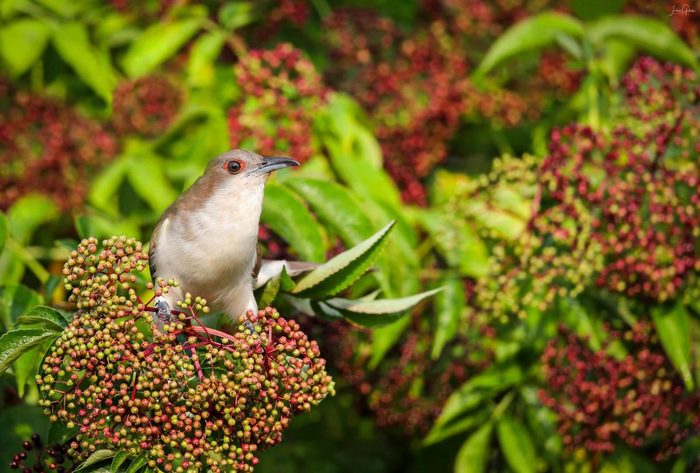
There are good native alternatives to Amur maple and Amur honeysuckle. Give elderberry (Sambucus nigra canadensis) plenty of room to spread and grow in Zones 3 to 9, as it can be anywhere from 5 to 12 feet tall and wide. Then watch as both butterflies and bees gather on flowers and as birds flock to the ripe fruit. Although it prefers full sun and moist soil, it tolerates drier conditions once it’s established. As an added bonus, elderberry suckers form large and lush thickets, which are perfect hiding spots for songbirds. Or try one of these native trees that attract birds to your backyard.
Sweetspire (Itea virginica) is a native shrub that grows in Zones 5 to 9 and has a long and colorful display. The glossy green leaves turn yellow, orange, crimson or scarlet in fall. During spring, butterflies will swarm to the fragrant white flowers.
Turn up the heat in your borders and natural plantings with spicebush (Lindera benzoin). This native beauty grows 6 to 12 feet tall and wide in Zones 4 to 9. Enjoy radiant yellow blooms in spring, bright fall colors, and red fruit to steal the show once the foliage drops. Though spicebush prefers moist, well-draining soils, it tolerates damp soils along creeks and wet woodlands. Plus: It’s a host plant for spicebush swallowtails and other swallowtail butterflies.
Next, discover whether a donkey tail succulent is invasive.
The classic cup of woven sticks, like a robin nest, is just one of many types of bird nests. Shorebird and nightjar nests are barely present, just slight divots on the ground. Orioles construct some of the most elaborate woven baskets, which hang as pendulums from tree branches. A few species, including burrowing owls, puffins and kingfishers, nest in underground tunnels.
“Nests are little climate-controlled structures perfect for eggs and hatchlings,” says Sarah Winnicki-Smith, a Ph.D. candidate in avian evolutionary ecology at the University of Illinois Urbana-Champaign.
Check out eight different types of bird nests below and learn where various species choose to set up house.
Follow these 9 proven tips to attract nesting birds.
On This Page
Long-Lasting Large Bird Nests
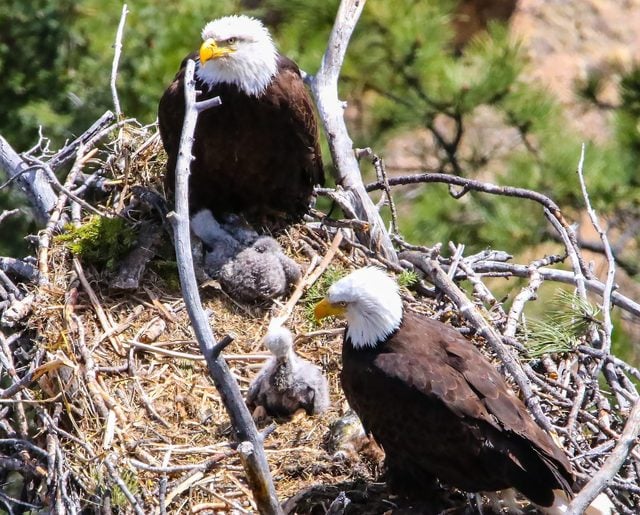
The grand champion bird nest-builder is… the bald eagle! In 1963, an eagle’s nest near St. Petersburg, Florida, was declared the largest at nearly 10 feet wide, 20 feet deep and over 4,400 pounds. That nest was extreme; most bald eagle nests are 5 to 6 feet in diameter and 2 to 4 feet tall. Nest construction can take three months. Eagles typically reuse the same nest year after year, adding to it each season.
Learn about birdscaping: Grow plants for nesting birds.
Flexible, Small Bird Nests
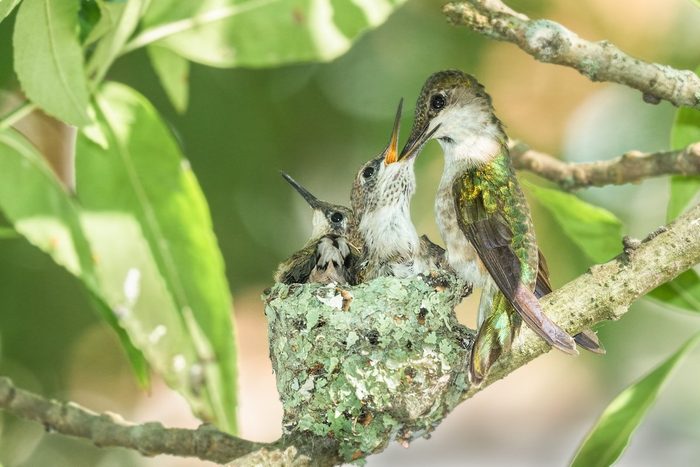
It should come as no surprise that hummingbirds, our smallest birds, make the smallest nests. Hummingbirds build nests on top of tree branches, using plants, soft materials and spider webs. Ruby-throated hummingbirds decorate theirs with flakes of lichen. Anna’s hummingbirds may lay eggs before a nest is completed, continuing to build the sidewalls during incubation. Most impressive is how these nests stretch. Female hummingbirds usually lay a pair of eggs the size of black beans inside a nest about the diameter of a quarter. As the baby hummingbirds grow, the nest expands, keeping things tight and cozy.
Learn more about hummingbird nests.
Pendant Oriole Nests
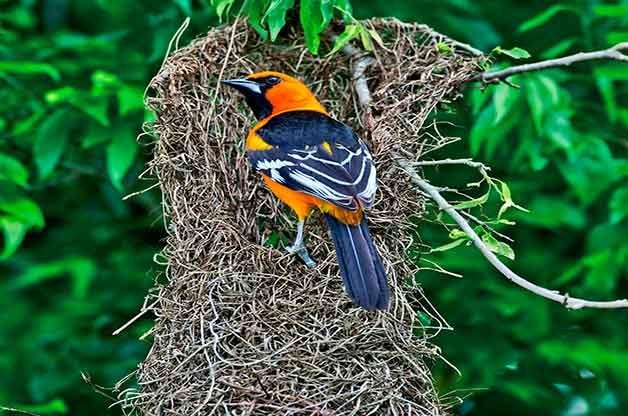
Orioles are the seamstresses of the bird world. Their iconic pendant nests dangle from outermost tree branches. Oriole nests are impossible to miss among the barren winter branches and nearly as impossible to spot, surrounded by leaves, during the breeding season. Orioles use whatever material is available to stitch their bag nests: long grasses, twine, even horsehair. The nests are lined with soft nesting material such as plant fibers, feathers or animal wool. The Altamira oriole of extreme south Texas and Central America constructs one of the longest dangling nests, which can hang down more than 2 feet.
Learn how to identify baby orioles and juvenile orioles.
No-Fuss Scrape Nests
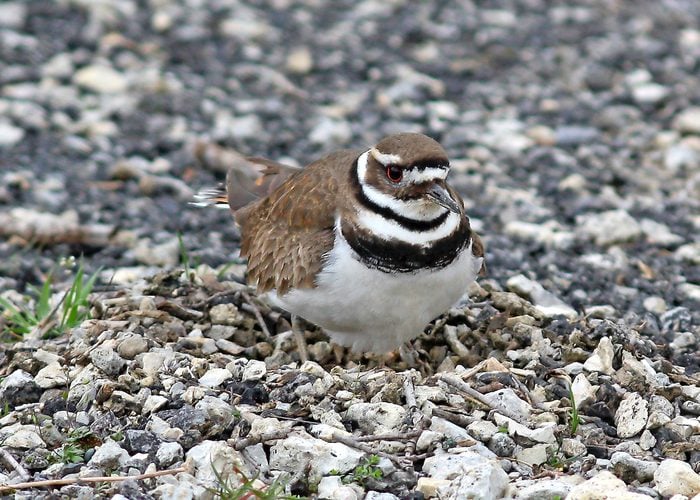
It’s the exception rather than the rule, but a few species of birds get away with building hardly any nest at all! This doesn’t mean they are haphazard in their approach to laying eggs, though. Beach nesting birds (including black skimmers, many species of terns, and piping, Wilson’s and other plovers) lay eggs in shallow depressions scraped out in the sand. Killdeer opt for no-fuss nests by laying eggs in the open, usually on gravel or dirt, before adding sticks, rocks or other natural elements. The remarkable thing about the eggs of these species is their cryptic camouflage coloration. Eggs are often speckles and match the sandy granules of the makeshift nests. Sometimes these birds will line the shallow scrape with shells or sand to add to the camouflage. As beaches get more developed, some of these beach nesters have adapted to laying eggs on nearby rooftops.
Learn about mourning dove nests.
Precarious Cliffside Nests

Huge colonies of murres and guillemots nest on rocky coastal cliffs. Most lack any structural types of bird nests, instead laying eggs that are extra pointy on one end. This shape helps the eggs pivot around the point instead of rolling over the edge. These ledge nesting sites are also more protected from predators. Cliff nesters aren’t found only on coasts. Lots of species, including condors, ravens and falcons, use cliffs, but they build stick nests in the crevices.
When do bluebirds nest and lay eggs?
Floating Nests
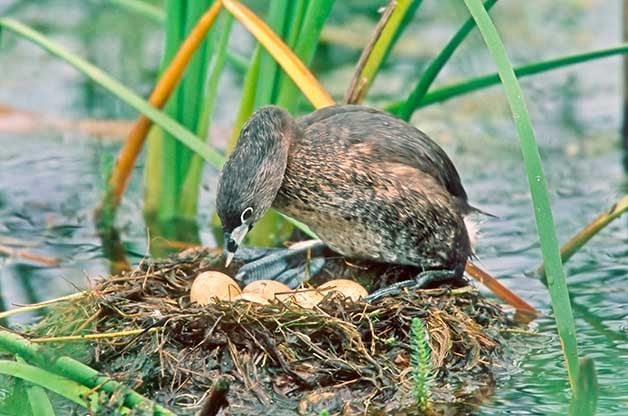
Some waterbirds, including many ducks, nest in upland grasslands far from water. Others, such as loons, grebes, coots and gallinules, nest directly on top of the water. Eggs will sink, so the birds build floating platform nests out of cattails, reeds, other aquatic vegetation, or mud. They anchor the nests to emergent vegetation to conceal them and to keep them from drifting away.
Discover more interesting facts about bird nests.
Underground Bird Nests

Underground types of bird nests are called burrows. Burrowing owls in Florida will sometimes dig their own burrow, while the burrowing owls in the west usually rely on spots excavated by prairie dogs, badgers, tortoises or other diggers. Other underground nesters include bank swallows, belted kingfishers and Atlantic puffins.
Find out more about burrowing and ground nesting birds.
Early Bird Nests

It is hard to say officially whoooo lays the first eggs each year, but my pick for my favorite bird nests is the great horned owl. Sure, many species can begin nesting in January in southern states, but it is still winter in the northern states when great horned owls start incubating their eggs in nests made of sticks, often in trees. It’s essential that these owls get an early start on nesting, because the species is slow to hatch and fledge. It is remarkable to think of the owls sitting on eggs as snow piles up during frigid nights.
Learn how to attract owls to nest in your backyard.
Cavity Bird Nests
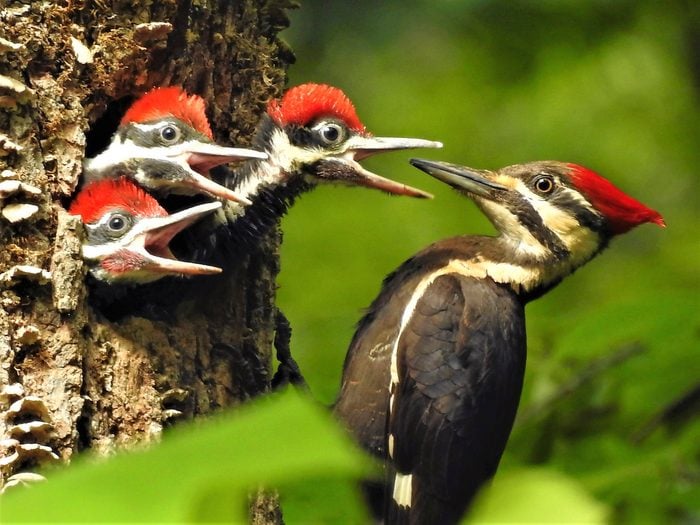
Primary cavity nesters, such as woodpeckers, excavate holes in trees and cacti for nesting. Secondary cavity nesters, such as bluebirds, chickadees and tree swallows, use these holes or set up housekeeping in birdhouses. Learn how to build a DIY bluebird house.
“Weeds have overtaken my mulched borders. I cleared them by hand and treated the area with vinegar, but they keep coming back. I’m looking for a natural way to kill weeds. What should I do?” writes Birds & Blooms reader Pat Northington of Austin, Texas.
Vinegar just kills the tops of existing weeds. This may be enough to kill young seedlings, but it does not prevent weed seeds in the soil from sprouting. Also, since vinegar does not move from the leaves down into the roots, more established plants and perennials resprout from the roots of underground rhizomes.
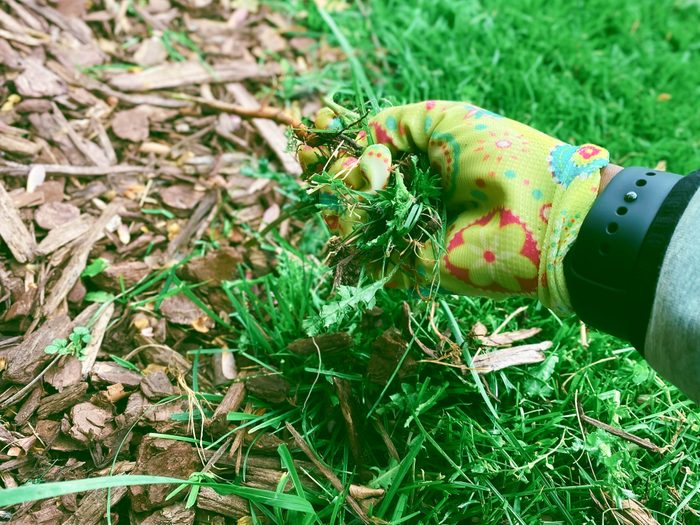
Several commercial organic herbicides use essential soaps and plant oils to kill weeds. Most just burn the leaves, are most effective on small plants and require repeat applications.
Check out 30 common lawn weeds and how to ID them. Plus, here’s how to get rid of Bermuda grass in your garden.
Corn gluten meal may also help you keep weeds at bay. It’s sold under several brand names as a treatment that prevents seeds from sprouting.
For the best natural way to kill weeds, consider a combination of these options. You’ll likely have the best results. Also keep in mind that compost and mulch help healthy plants outcompete the weeds.
How to Kill Weeds Without Chemicals

“Are there any new techniques for getting rid of winter and early spring weeds without chemicals?” asks reader Joe Green.
Unfortunately, there are no new magic solutions for managing weeds without harmful chemicals. For annual flower and vegetable gardens, try solarizing the plot before planting. Cover the garden bed with clear plastic for several weeks. This kills the existing weeds and many of the weed seeds. Then cut back the dead weeds to the soil surface and lightly cultivate if needed. Avoid deep digging, which can bring new weed seeds to the surface. For perennial gardens and mixed borders, remove weeds (roots and all) and cover the soil surface with organic mulch. This helps prevent many weed seeds from sprouting and improves the soil as the mulch breaks down. Mulch will not kill existing perennial weeds.
Next, learn how to stop bindweed from taking over your garden.

Bearded Iris Flower Types Are Widespread
Bearded irises are among the most commonly planted iris flower types and are divided into six different classes by the American Iris Society.
Another plus to growing bearded irises: They grow in Zones 3 to 9, which means they’re found in 49 states—all except Hawaii.
Iris not blooming? Here’s what to do.
Try Large Siberian Iris and Dwarf Iris Flowers
Irises come in a wide array of sizes and looks. Siberian irises can reach a whopping 4 feet tall, while dwarf irises max out at 6 inches.
Check out more iris flower types and facts you should know.
Irises Love Sunlight

Most irises thrive in full sun for at least six hours per day. The rhizomes should be partially exposed to light and air to keep them dry and safe from rot.
Check out 10 purple flowers to grow in your garden.
Choose to Grow Native Iris Flower Types
You can find 28 native plant species of irises in the United States, including western blue flag, crested and Klamath.
Get care and growing tips for blue flag iris.
Most Iris Flower Types Are Perennials
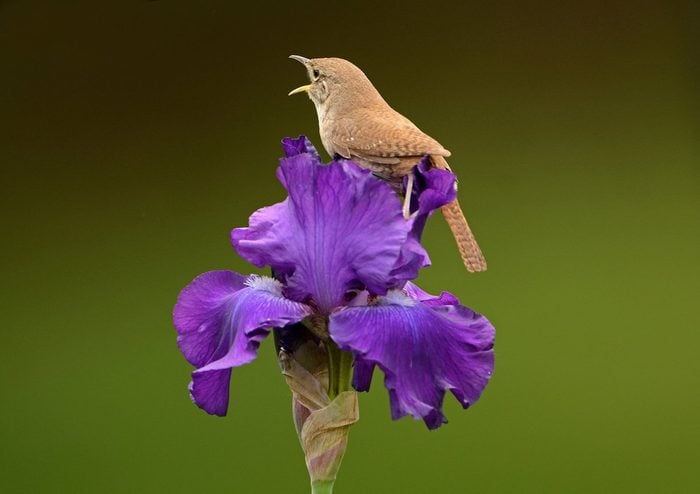
Almost 300 species exist within the iris family. Most are perennials that grow via rhizomes, which are horizontal underground plant stems that form shoots.
Next, learn how to grow Louisiana iris.
Bluebird Meaning and Symbolism
You might have heard the phrase “bluebird of happiness,” and as it turns out, there’s some truth behind it. What is the meaning of a bluebird sighting?
Around the world, bluebirds have a wide variety of associations and meanings, all of which carry positive connotations. Some believe the bluebird is a symbol of joy and hope; others, that good news will be arriving soon. Others still think that bluebirds represent a connection between the living and those who have passed away. Native American tribes in particular associated bluebirds with the return of spring after winter, prosperity and even fertility.
Learn how to attract bluebirds.
“This male eastern bluebird (above) landed on my neighbor’s fence. I thoroughly enjoy photographing birds, and I thought the blue and orange background looked really pretty and matched the bluebird quite nicely. They say bluebirds bring happiness. This one did, for me. At the time my father was in hospice, dying from Stage 4 colon cancer. This photo turned out to be the last picture of a bird that I took before my dad passed. This photo will always be extremely special to me for that reason. My dad was saying goodbye in a way I would understand… through a bird,” shares Birds & Blooms reader Nikki Debraccio.
It’s difficult to pinpoint exactly how the bluebird meaning became the bird “of happiness.” (Psst—if you see a cardinal, here’s what it means). A popular song from 1934 titled “Bluebird of Happiness” might have something to do with it, as might a 1908 play called “The Blue Bird.” But bluebirds were associated with glad tidings in European and Native American folk tales, as well as in Chinese mythology, all of which were written long before the song. Regardless of culture or even century, bluebirds bring joy.
Here are the best bluebird feeders and feeding tips.
Bluebirds Bring Happiness

“In Canada the winters are quite long. I always look forward to the arrival of spring, and one of the earliest visitors to show up is the mountain bluebird. I love their deep blue color. It reminds me of warm summer days with blue skies,” Birds & Blooms reader Wendell Shaw says.
When do bluebirds nest and lay eggs?

“Feeling a little down, I set out on a hike one morning to lift my spirits. I heard this male eastern bluebird before I saw him. He landed on a branch long enough for me to get a photo. Instantly, my blues were banished, and I smiled as I walked back down the trail,” Birds & Blooms reader Dave Weth says.
Learn how to make a DIY bluebird house.

“It was Mother’s Day Sunday, and I knew this family of eastern bluebirds was about to fledge the nest. After dinner with my mother, mother-in-law and all the family, I grabbed my camera and went out to check the nest box. As I walked toward the nest box, I noticed the parents were strangely absent. I listened closely and didn’t hear the hungry cries of the nestlings. They had fledged and I had missed it, or so I thought.
Suddenly, I caught a flash of brilliant blue. Scanning the trees, I spotted Poppa Blue and his five beautiful fledglings lined up on a tree branch several yards away. Not wanting to disturb this precious family, I froze where I stood, zoomed in as best I could, and snapped my favorite bluebird photo of all time. Just seconds after Poppa Blue fed his hungry babies, he flew off to gather more insects, and Momma Blue arrived to feed from the other end of the line. My heart was happy for so many reasons on that Mother’s Day,” Birds & Blooms reader Carla Ginn says.
Next, find out do hummingbird sightings and robin sightings have special meaning? Plus, we chatted with our field editors about what seeing a wren means to them.